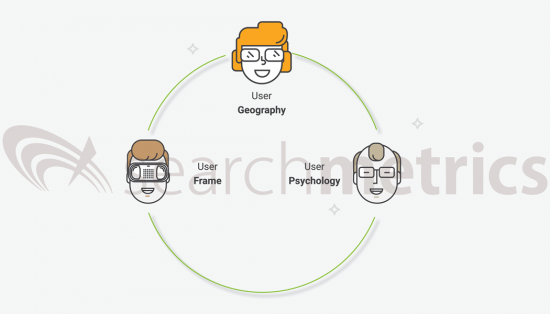In recent years, content marketing has become a fixed component of many brands’ online marketing strategies. Overall content output has noticeably increased, and many are already wondering how much of this content is really reaching its target audience. How much is actually relevant? In this installment of Unwrapping the Secrets of SEO, we dig into user-focused approaches to succeeding online.
Content marketing continues to be an effective way of achieving high rankings and generating outreach. However, the strategies required to make this happen have changed dramatically over the last few years.
User > Intent >Topics > Keywords
The focus has to be on the user, who must be placed at the center of all considerations: regarding content, topics and structure of texts. This is fundamental to a user interacting with the content on offer. Positive signals that the user provides through their interactions with a text they like (longer time-on-site, more clicks to other pages, less bouncing back to the SERP) increase the likelihood of the content being rewarded with good rankings for relevant keywords.
In the following, the factors that are particularly important for a user-focused approach to content optimization will be presented, with an explanation of how these can be incorporated into content creation. Here, we look at three different aspects of the user:
- User Psychology
- User Geography
- User Frame
User Psychology instead of Keyword Density
For a long time, the keyword density of a text was the decisive factor for content marketing success. All content had to be search engine optimized, which often resulted in Keyword Stuffing and texts that were hard to read. This tactic did lead to good rankings, yet engagement and interaction rates remained modest because of the unpleasant reading experience for the user.
Today, the aim is often to create content that appeals to the user on the basis of target group analyses. However, it is more appropriate to develop content based on an understanding of what motivates the user. This requires a detailed understanding of User Psychology, which can also be used for the development of different user personas.
User Psychology consists of four basic elements:
- Intent: Intent determines whether each content piece is relevant to the user. For example, if the intent is informational, then the user expects serious content that gives them a detailed understanding of the topic. If the user intent is transactional, then the content can – and should – be more emotional, shorter and more entertaining.
- Expectation: Expectation and intent are closely connected. The user’s expectations can differ depending on the intent. At the same time, expectation also considers other factors such as the person’s level of education, interests, experience and ideas. Addressing the user’s full range of expectations is best done by following a holistic approach that expands on basic information like definitions with detailed expert knowledge.
- Desire: Desire refers to the emotions that connect the user to the content. The desire is made up of both cognitive and emotional needs. The former is the reason for interacting with a certain topic or object, whilst the latter is a feeling that will hopefully emerge from this interaction. An example desire would be someone wanting to gain expertise to stand out amongst their colleagues.
- Attraction: Attraction is created when user intent, expectation and desire are all fulfilled. The strength of attraction dictates the success of the Call-to-Action and therefore of the whole sales funnel. If the content meets the user’s expectations and satisfies the user’s needs, then the potential for engagement increases exponentially.
You can find out how to identify keywords and their semantic environment with the help of a variety of examples in our whitepaper –> “Content that Performs!”
User Geography for Efficient Touchpoint Identification
Alongside the User Psychology analysis, the pinpointed seeding of content to reach the target audience is of critical importance for the measures’ success. To achieve this, the user’s customer journey should be mapped out in detail in order to enable a highly accurate identification of touchpoints. Determining User Geography means establishing exactly where the user is in the Sales Funnel or on the User Journey.
To identify touchpoints, the entire customer journey has to be evaluated so that the user can be provided with content that is relevant to them at every stage. This is the only way to guarantee that content optimized according to the User Psychology reliably reaches the target audience and is able to generate reach effectively.
User Frame
While User Psychology and User Geography reflect concrete needs and expectations, the User Frame defines the topical and requirement framework for the target audience. Part of this is the identification of relevant topics and related keywords with the help of a software solution like the Searchmetrics Content ExperienceTM. This enables a direct comparison with the competition and the identification of as yet unoccupied niches that have a high potential for generating conversions.
In addition, a software solution is useful for the development of a semantic field of association that makes it possible to identify further relevant keywords and terms that are frequently used in the appropriate context. Identifying such keywords helps to create search engine optimized texts and can have a positive impact on rankings.
Next Steps: Search Volume, Competitors, Potential for Optimization
After the keyword analysis, it is worth looking closely at Google KPIs. How high is the search volume? Which competitors are currently ranking for this keyword? What kind of content is currently performing well? A detailed analysis of the search results makes it possible to identify potential for optimization, and discover which niches exist that are not yet occupied by the competition.
Our whitepaper provides a detailed description of how the theory of User Psychology, User Geography and User Frame can be applied in practice – with the support of the Searchmetrics Content ExperienceTM.
Whitepaper: Content that Performs!
Conclusion: User Focus Yields High Potential for Performance
Anyone who publishes content today without placing the user at the center of the content’s development will have difficulties generating traffic. On the other hand, by considering psychological and contextual aspects, we can create content that targets the user’s intent and expectations, and draws the user into the conversion process.
To optimize your own content in this way, the three-pronged analysis of User Psychology, User Geography and User Frame provides an important support and orientation that is essential for content planning and creation, and that leads to potential for high rankings.


